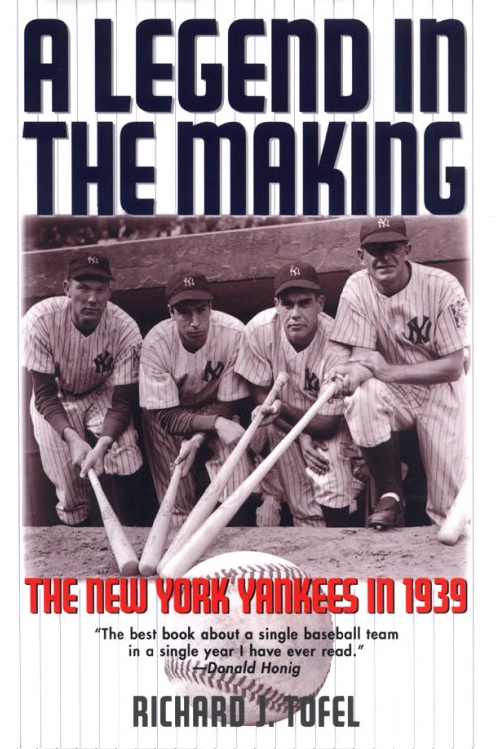

Review by Ron Kaplan
There is something mythical about 1939. It was a year when the rumblings of war in Europe grew louder while Einstein warned Roosevelt that the Nazis were getting closer to developing an atomic weapon. While this was going on, Americans were doing there best to ignore the coming storm by escaping to the New York World’s Fair and with films like Gone With The Wind and The Wizard of Oz.
When it comes to baseball, 1939 was also a landmark year. Aside from being the questionable centennial of the national game, it marked the debut of Ted Williams, the opening of the Hall of Fame and the sad demise of Lou Gehrig’s career.
It is the year, also, that arguably sets the Yankees apart as the greatest team of all time. They won 106 games, while losing just 45 to finish 17 games ahead of the second place Red Sox. They capped their run by sweeping the Reds in the World Series.
Richard Tofel relives the team’s juggernaut run through the baseball world with a combination of concise reportage and historical perspective.
Without going into laborious detail and statistical meanderings, Tofel replays that special season, reminding the reader that teams are not composed merely of star players, but also of average fellows who have their good days and bad. (Even the Erle “Doc” Painter, the Yankees’ trainer, gets his due, though not in a complimentary light, but such was the case of that position in those days). In the case of the 1939 team, of course, there were more ups on the field then downs.
The major underlying story of Legend, however, takes place outside the white lines. The author uses anecdotal information as well as impressions of teammates and Eleanor Gehrig to impart the decline of the once-awesome Lou due not to the aging process, but by something much more insidious.
As the 1939 season eased from spring training to regular play, the sportswriters who covered the Yankees noticed a sharp dropoff in ability from the Yankee first-baseman, carried over from the 1938 season. Tofel argues, correctly, that the falloff is relative only to Gehrig’s great seasons. His numbers, a .295 batting average, 29 home runs and 114, RBI, still place him in above average. While some attributed it to the wear and tear of playing over 2,100 consecutive games, others, perhaps more sharp-eyed and sensitive, worried that there was something more to it. Teammates, in the typical unenlightened manner of youth and selfishness, complained that Gehrig’s faulty play put them at risk. It was only after tests at the Mayo Clinic confirmed the worst that they sheepishly came around.
The question posed (but not adequately answered) by Tofel is how much did Gehrig understand about his fate. Some sources have indicated that the Iron Horse was not the brightest of men and doctors kept the ultimate diagnosis from him. Others claim he was keeping up a brave front to protect his family. Either way, the tribute according him on that July 4, at which he claimed to be the “luckiest man on the face of the earth,” ranks as one of the most moving in sports history.
Tofel knows that the Yankees did not operate in a vacuum and reports on some of the other doings both in and outside baseball. For example, America was at the height of the Depression, with millions out of work. Here he uses his background as a vice president of Dow Jones & Company to put into meaningful and relative terms the salary structure of the day. Old timers complain about their inadequate salaries but Tofel shows that while the amounts might seem small, they were actually well above most blue collar workers of the era and quite good in current dollars. On the other hand, he appears too cavalier when he notes “The Germans invaded Poland on September 1, 1939. The next day the Yankees rolled into Boston, their train three hours late from Cleveland.” But it may be his sly way of indicating the minimal impact the beginnings of World War II had on America.
Within the game, he notes the increasing impact of night games and radio broadcasts in the baseball landscape.
Legend concludes with a “Post-Game Report” which follows the fates of the team following 1939, led, understandably, by Gehrig’s death in 1941. Tofel also begs the question was this team truly the greatest ever? The reader will have to decide that answer.